Phaeton (carriage)
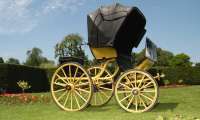
%2C_19th_century.jpg)
A Phaeton (also Phaéton) was a form of sporty open carriage popular in the late eighteenth and early nineteenth century. Drawn by one or two horses, a phaeton typically featured a minimal very lightly sprung body atop four extravagantly large wheels. With open seating, it was both fast and dangerous, giving rise to its name, drawn from the mythical Phaëton, son of Helios, who nearly set the earth on fire while attempting to drive the chariot of the sun.
With the advent of the automobile, the term was adapted to open touring cars, also known as phaetons.
Types
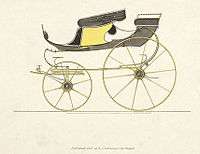

The most impressive phaeton was the English four-wheeled high flyer. The mail and spider phaetons were more conservatively constructed. The mail phaeton was used chiefly to carry passengers with luggage and was named for its construction, using "mail" springs originally designed for use on mail coaches.[1] The spider phaeton, of American origin and made for gentlemen drivers,[1] was a high and lightly constructed carriage with a covered seat in front and a footman's seat behind.[2] Fashionable phaetons used at horse shows included the Stanhope, typically having a high seat and closed back, and the Tilbury, a two-wheeled carriage with an elaborate spring suspension system, with or without a top.[3] A variation of this type of a carriage is called a Victoria, with a retractable cover over the rear passenger compartment.
Use
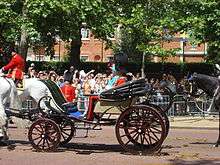
Each June, during the official Queen's Birthday celebrations, Queen Elizabeth II travels to and from Trooping the Colour on Horse Guards Parade in an ivory-mounted phaeton carriage made in 1842 for her great-great-grandmother, Queen Victoria.[4]
In her later years, Queen Victoria greatly enjoyed travelling in a phaeton drawn by a single white donkey, or mule, when on her holidays in Cimiez, then a small village on the outskirts of Nice, in the South of France. There is a print of the monarch enjoying her morning excursions on page 490 of the Illustrated London News of April 10, 1897. In addition, there is a photograph in the Royal Collection, dated 1898. There are also other photographs, using a black donkey, taken at Windsor Castle.
Bolshevik revolutionaries used a phaeton to get away after carrying out the 1907 Tiflis bank robbery.
Valerie, Lady Meux would startle London Society by driving herself in a high phaeton drawn by zebras.
In fiction
Cinema

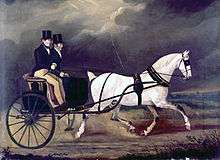
In the 1995 film Sense and Sensibility, the character Mr. Willoughby drives a yellow phaeton. While the phaeton seems to exhibit his reckless and dashing character, in the novel on which the film is based, the original character drives a curricle. [5]
In the 2012 Bengali film Bhooter Bhabishyat, Raibahadur Darpo Narayan Chowdhury often refers to phaetons in reference to Sir Donald Ramsay and to his own aristocratic status.
In Turn:Washington's Spies, season 3 episode 1 Benedict Arnold is riding in a phaeton spider.. He states to Peggy Shippen "Do you like it? It's a Phaeton Spider". then goes on to say "I had it fit with a Collinge axle for a smoother ride".[6]
Literature
In Frances Burney's novel, Evelina (1778), young gentlemen race their phaetons on the public highways of Clifton, near Bristol, not without incident.
In Jane Austen's Pride and Prejudice, Mr Collins says of Lady Catherine De Bourgh's daughter, "she is perfectly amiable, and often condescends to drive by my humble abode in her little phaeton and ponies."
In Anne Brontë's The Tenant of Wildfell Hall (1848), Mr. Huntingdon drives a "light phaeton" that comes "bowling merrily up the lawn" (Ch. 18). The sporty character of the carriage reflects Huntingdon's devil-may-care attitude. She also references a phaeton in Agnes Grey, "the useful pony phaeton was sold.."
In the 1928 American children's book Freddy Goes to Florida (formerly published as To and Again) by Walter R. Brooks, Hank the farm horse draws an old phaeton that carries the animals and their treasure back from Florida to the Bean farm.
In Absalom, Absalom! by William Faulkner, Sutpen's wife Ellen had a phaeton that caused her daughter to become greatly distressed when it arrived in place of their normal carriage.
In the short story "The Curious Case of Benjamin Button" by F. Scott Fitzgerald, Roger Button, Benjamin's father, owns a phaeton that is his primary mode of transportation until Benjamin buys the first automobile in Baltimore.
In Susannah Kells' novel Fallen Angels, a phaeton is the transportation of choice for the main character, Campion, who later crashes the carriage in a perfect example of its dangerous and fickle reputation.
The character Mr. Spenlow from the novel David Copperfield dies suddenly of a heart attack while driving his phaeton home.
Henry James, in his short story "An International Episode" (1878) has Lord Lambeth driven through town in "a little basket-phaeton" by his companion Bessie Aldon. "His companion went into seventeen shops — he amused himself with counting them — and accumulated, at the bottom of the phaeton, a pile of bundles that hardly left the young Englishman a place for his feet. As she had no groom nor footman, he sat in the phaeton to hold the ponies..."
Georgette Heyer, the Regency Romance novelist, frequently wrote about sporting gentlemen driving their phaetons. Sometimes they allowed young ladies to drive their phaetons, but only in exceptional circumstances.
Gallery
-

A jump seat phaeton
-
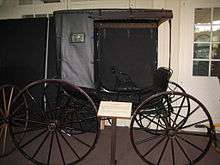
Another view of the same jump seat phaeton
-
Phaeton carriage in Geraz do Lima Carriage museum
-

Argentine Presidential Phaeton in the Museo del Bicentenario, Buenos Aires
-
A phaeton
-
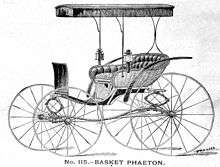
Basket phaeton
engraved by John Henry Walker -
.png)
A typical Phaeton
See also
References
- 1 2 Gregersen, Erik; Levy, Michael I., eds. (2012). The Complete History of Wheeled Transportation: From Cars and Trucks to Buses and Bikes. Britannica Educational Publishing. ISBN 978-1-61530-728-9. Retrieved 2014-05-20.
- ↑ Gove, Philip Babcock, ed. (1966). "S". Webster's Third New International Dictionary of the English Language, Unabridged. L–Z. Springfield, Mass.: G & C Merriam. p. 2194. ISBN 0-7135-1037-4.
- ↑ Smith, D. J. (2004) [1994]. "Owner-driven passenger vehicles". Discovering Horse-drawn Vehicles. Princes Risborough, Bucks. UK: Shire Publications. p. 68. ISBN 0 7478 0208 4. Retrieved 2014-05-20.
- ↑ "Trooping the Colour (The Queen's Birthday Parade)", The British Army official website
- ↑ Sense and Sensibility/Chapter 13
- ↑ http://transcripts.foreverdreaming.org/viewtopic.php?f=229&t=26887
External links
| Wikimedia Commons has media related to Phaetons. |
- MNC - Spider Phaeton. Museu Nacional dos Coches (National Coach Museum), Lisbon, Portugal